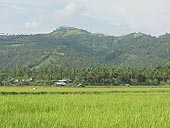|
| Baao, Camarines Sur, Philippines | |
|
A Short History Orlando "Orly" Olaño According to one oral tradition, the town of Baao got its name from the local term, bao-o, or freshwater turtles. These reptiles were said to be once abundant in the wetlands surrounding the pre-Hispanic settlements of neighboring Binanuaanan, Layuan and Binabaloy and may have used the higher and drier lands of these settlements as nesting sites. Located on fair-sized bacolods or mounds roughly in the shape of turtle carapaces and higher than the marshes, swamps and lakes of the southern Bicol River valley, these three early Baao settlements may have been generically known as kaba-o-o-wan; or in the present contracted word form, kaba-awan. Early Peoples The pre-Hispanic Baao peoples belong to two different ethno-linguistic groups, the Agtas and the Indo-Malays. It is believed that the semi-nomadic Agta (also known as Itom or Tabangnon) of Negroid stock were the first people who roamed the hinterlands of Baao. Basically hunter-gatherers, the Agtas lived-off the bounty of the forests in the hills of west Baao. These people are now limited to small settlements in the barangays of Caranday, Tapul, Iyagan, Nababarera and Antipolo. The second wave of migrants belonging to the Indo-Malayan stock with their sedentary riverine culture settled on the fertile lowlands along the banks of the Bicol River and its tributaries. These sea-faring people may have come inland the Bicol River valley by following the river's course from its mouth in the San Migual Bay-Libmanan-Cabusao area and by leap-frogs settled the open dry lands along the riverbanks. Following the seasonal cycle of the Baao area, these people fished when floodwaters cover most of the lowlands and cultivated rice when low water level during summers permit them to plant. Most native Baaoeños today draw their ancestry from these people.
|
|
|
|
